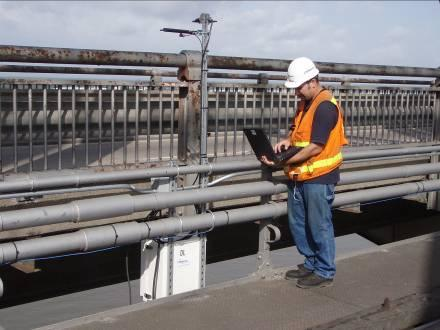




ヒューイ P. ロング橋の 4 つの主スパンは、ルイジアナ州ニューオーリンズのミシシッピ川に架かっており、全長は約 2,400 フィートです。この片持ち式鋼製トラス橋は 1935 年に開通し、ニューオーリンズ公共ベルト鉄道が所有および運営しています。この橋は現在、トラス間に複線鉄道が通っており、各トラスの外側に片持ち式で 2 車線の車両交通が通っています。車両交通の流れを改善する必要性と、鉄道交通が途切れないことによる制約に基づき、ルイジアナ州運輸開発局 (LA DOTD) は橋を交換するのではなく、拡張することを決定しました。
橋の拡幅により、橋の両側の道路幅が現在の 18 フィートから 40 フィートに広がります。拡幅には、既存のトラスと平行に上流および下流のトラスの追加が必要になります。橋脚は、2 つの新しい拡幅トラスを支えるために、追加のコンクリート エンケースメントと鉄骨フレームで改修されています。
構造健全性監視プログラムは、拡張トラス部材から既存のトラス部材に予想される負荷量が伝達されているかどうかを評価するための予防措置として建設契約に含まれています。
CTLGroup は、Huey P. Long 橋の拡幅プロジェクトの仕様に従ってトラス監視システムを設計および設置する契約を獲得しました。トラス監視の仕様には、次の内容が求められていました。
- 既存のアイバー部材の初期固定荷重応力の決定
- 433 部材の建設関連応力測定用ひずみゲージの設置
- 31 部材の活荷重応力を測定するためのひずみゲージの設置
- 既存の5つの橋脚それぞれに2軸傾斜計を設置
- ゲージを読み取り、予測値と比較し、3年間の建設プロセスを通じて毎日レポートを提供する監視システム
- 監視システムを調整するための負荷テストの実行
合計 433 個の既存のトラス部材は、軸方向および曲げ荷重の影響を測定するために設計された 827 個の静的および動的ひずみゲージの配列で監視されています。さらに、傾斜計が橋脚の傾斜を監視します。静的システムでは、CTLGroup はコスト、組み込みの温度補正、およびリード線で長距離を配線できる機能に基づいて、バイブレーティングワイヤひずみゲージを選択しました。
トラス監視データ取得システムは、静的荷重監視システムと活荷重監視システムの 2 つの独立した監視システムで構成されています。静的システムでは、433 個の部材の 777 個のバイブレーティングワイヤ センサーを読み取る AM16/32 マルチプレクサを含む、線路脇に取り付けられた 23 個の NEMA エンクロージャを使用します。さらに、5 つの橋脚が、10 個のバイブレーティングワイヤ傾斜計、周囲温度、風速、風向を使用して監視されました。マルチプレクサ、データ ロガー、および中央コンピュータ間のワイヤレス通信が必要なため、システムは 24 個の AVW206 モジュールと RF401 スペクトラム拡散無線を組み合わせて構成されました。マルチプレクサはセンサーを読み取り、信号処理を実行し、線路脇の手すりに取り付けられた 4 個の CR1000 データ ロガーの 1 つにデータをワイヤレスで送信します。これらのデータ ロガーは、橋梁現場から約 1/4 マイル離れた MTI オフィス トレーラーにデータをワイヤレスで送信します。
このシステムの目的は、特定された部材の応力(ひずみ)を測定し、橋梁拡幅工事の過程で予測される応答と比較することです。これは次のようにして実現されます。
- 段階的な建設における予測応答の限界を確立する
- ベースライン変動(交通量/機関車の負荷と気温の影響)を考慮する
- 測定された応答と予測された応答の比較
- 予測された応答範囲外の制限を自動的にフラグ付け
システムは継続的に実行され、約 10 分ごとにデータを収集します。データはパスワードで保護された Web サイトに投稿されます。Web サイトでは、事前に設定された制限を超えたデータが視覚的に (色で) フラグ付けされます。
数百のバイブレーティングワイヤ センサーが関係するこの監視プロジェクトでは、新しいスペクトル分析方法を適用するのに適した環境が提供されました。結果は非常に良好でした。これまで、バイブレーティングワイヤ測定がこれほど多いアプリケーションでは、測定を検証し、ノイズの影響を受けたデータを特定するために余分な労力が必要でした。通常、ノイズ干渉により一部のデータが失われます。ただし、この場合はスペクトル分析によってノイズの問題が解消されました。データが失われることはなく、ノイズの影響を受けたデータを特定するために余分な労力は必要ありませんでした。
新しい方法によって提供される診断も有益であることが証明され、プロジェクト全体にわたって広範囲に使用されました。CTLGroup は、AVW206 がなければトラブルシューティングの問題は簡単に解決できなかっただろうと報告しています。同社はこれまで時間領域ソリューションを使用していましたが、この経験によりスペクトル分析法を全面的に支持するようになりました。